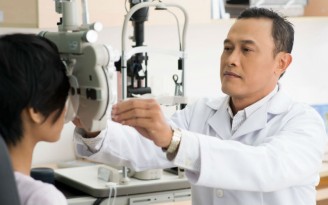
What you need to know about the computer vision syndrome
Nathan Rodrigues
Monday | May 15, 2017 | 3:45 PM | Last update: July 18, 2017, 10:01 AM (Brasilia time)
Here is a quick and simple question: how much time do you spend in front of a computer screen? If your answer is long hours every day, it’s time to begin looking after the health of your eyes.
Excessive use of a PC causes a series of eye problems. Many of its symptoms have already been classified by specialists and given rise to a new illness called computer vision syndrome (CVS). If you’re thinking "Goodness, I’ve never heard of that!" there’s a reason for it. The name is quite new. This problem is one of the many others that have arisen with the advance of technology.

Excuse the pun, but it’s good to keep an eye on this illness, OK?! =D
Understanding the problem
Computer vision syndrome can affect any person who frequently spends more than two hours in front of a PC. Let us explain why: as monitors are constituted by pixels—those tiny colored dots that make up the image and are used as a parameter for the screen resolution—we put a large amount of effort into maintaining focus on them. This adds stress to our eyes’ focusing muscles.
Imagine how tired your legs feel after you exercise them. Well, the same happens with your eyes.
Tiredness causes burning, redness, difficulty in focusing on the image, headaches, and discomfort in bright environments. Blinking less because of the effort to focus also helps worsen the symptoms, and since the role of blinking is to lubricate the eyes, they become dry.
How not to become a statistic
Do you spend too much time in front of a computer monitor because of your work or any other activity but don’t want to become a statistic? Simple care is enough for you not to join this list. Check this out:

— Pay attention to your posture! A bad position can speed up the eye fatigue process;
— Don’t have air-conditioning or fans pointing directly at your face. Environments with poor lighting also contribute towards your eyes getting tired more quickly;
— Prefer LCD screens. They have a better resolution and lighting, which tires your eyes less;
— Blink, even though it is intentionally. By lubricating your eyes, you prevent some of the symptoms of the syndrome;
— Establish a pause. If you use the computer for an hour, for example, take 10 minutes away from it to rest your eyes;
— You’re no longer sitting at your PC? Don’t rush to the TV or to the book shelf! Look for relaxing tasks to do.
#LetsTakeAction
The syndrome is a risk to the health of your eyes, but it can be treated. Everything will be resolved if you’re having medical treatment—which may include contact lenses and eye drops for preventing your eyes from drying out—and adopting the care we mentioned before, combined, of course, with a more moderate use of your computer. ;)
However, if this illness does not receive suitable treatment, it may become much more complicated, sometimes turning into a presbyopia. This usually occurs as part of the aging process, but may be brought on earlier by the excessive and continuous use of a computer.


